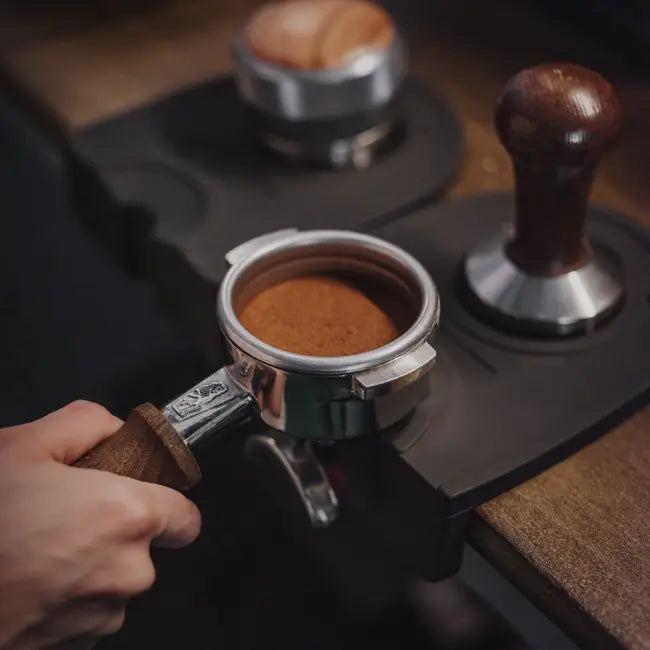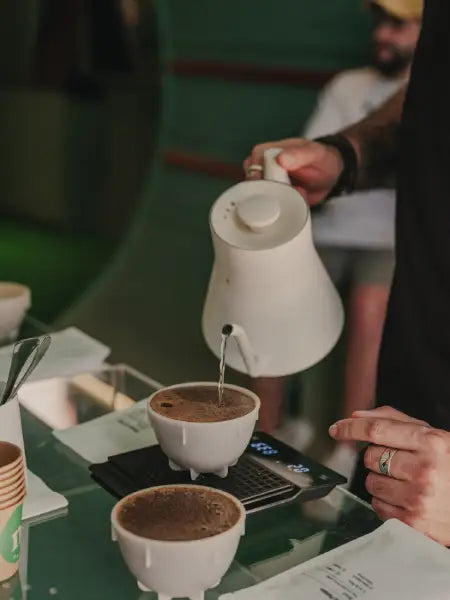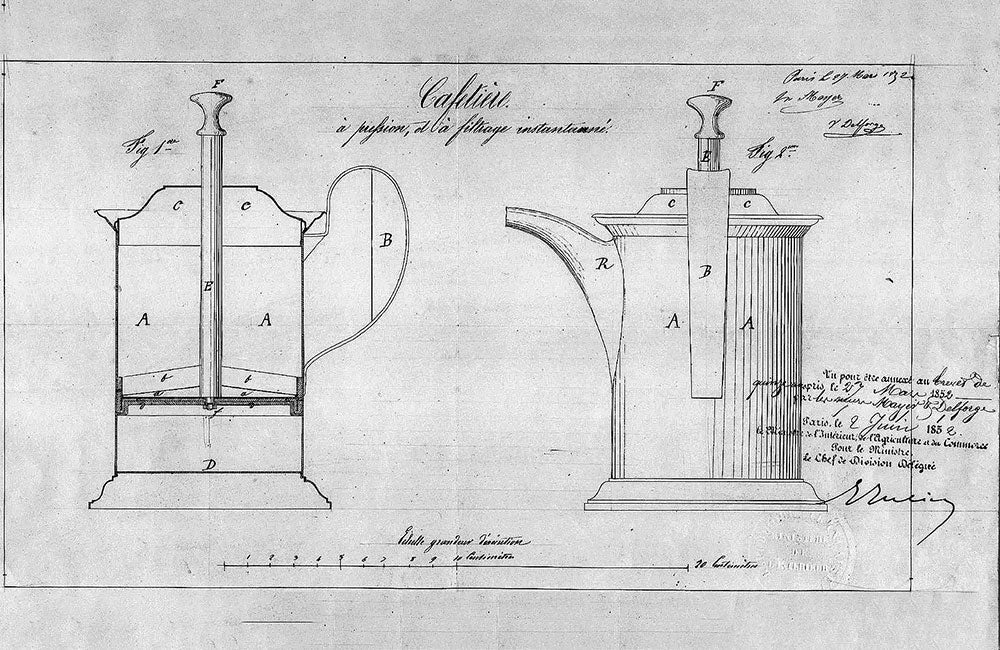Cafeteras de émbolo, su historia
Una de esas calurosas tardes de verano en Sevilla, en las que hasta los girasoles buscan la sombra, algunos amigos decidimos ir a buscar un refugio.
Hicimos todos los preparativos pertinentes para pasar el fin de semana fuera: espray anti-mosquitos y café en grano de especialidad con toda la parafernalia -digna de buenos frikis- para prepararlo. O eso creíamos nosotros. También llevábamos tienda de campaña, comida y otras cosas, pero nada de eso era realmente esencial.
Encontramos un lugar recóndito en la sierra junto a la ribera de un río. Era el paraíso. La temperatura durante el día no pasaba de 28 o 30 grados, que, comparados con los 42 de Sevilla, nos hacía plantearnos nuestras decisiones existenciales.
El caso, que nos despertamos a la mañana siguiente, después haber pasado hasta frío, y nos dispusimos a llevar a cabo la tarea más importante de un domingo por la mañana de camping: hacer un café.

Moliendo café con dos piedras por habernos olvidado el molinillo
Pero no cualquier café. Llevábamos nuestra AeroPress, camping gas, café en grano y… nos lleve el diablo, no teníamos molinillo. Se nos había olvidado en casa, a 250 km.
El pueblo más cercano estaba como a media hora y la sola mención de café de especialidad haría que nos miraran como lo que éramos: sibaritas de ciudad en el campo.
Haciendo una regresión a un estado evolutivo anterior, probablemente por la falta de cafeína, decidimos probar a moler el café con dos piedras que buscamos en el río (para que fuesen planas y estuviesen limpias). Y, con mucha dedicación y poca cabeza, conseguimos moler el café.
Dice la leyenda que así fue como se inventaron las cafeteras de émbolo. Un sujeto de origen francés olvidó su cafetera mientras se encontraba de viaje. Así que decidió echar el café molido directamente al agua y luego busco un filtro que le permitiera empujar el café hacia el fondo del cazo con un instrumento cilíndrico y alargado. De metal. Et voilà, había inventado la cafetera francesa, un nombre muy original. Por suerte, también se la conoce como cafetera de émbolo o cafetera de pistón.
¿Y la historia “oficial” de las cafeteras de émbolo?

Diseño de cafetera de émbolo Attilio Calimani y Giulio Moneta
Como suele pasar, la “historia oficial” es mucho más aburrida que la que os acabamos de contar y no por ello más cierta. La diferencia es que para la historia oficial contamos con un registro de patentes que nos indica una fecha: 1852.
No sabemos si fue el mismo individuo de origen francés de nuestra historia, o unos compatriotas suyos, quienes registraron por primera vez la patente de una rudimentaria cafetera de prensa francesa. Sus nombres eran Mayer y Delforge y nos gusta creer que uno de ellos era el mismo, puesto que nos da esperanza de que podamos patentar un nuevo método para moler café. Lo hemos llamado: molinillo de roca española.
Pero el diseño del francés tenía algunas lagunillas, principalmente, que no hacía un efecto sellante dentro del recipiente por lo que el café volvía a mezclarse con el agua, aunque en menor cantidad.
Así que unos italianos decidieron que ellos lo podían hacer mejor (¡cómo no!) y registraron una nueva patente en 1929. Y, para completar el chiste, un suizo, Faliero Bondanini (que por el nombre podría ser el primo listo de los italianos) diseñó y patentó la cafetera de émbolo que conocemos y usamos hoy.

Cafetera de émbolo que usamos hoy día
El suizo, haciendo honor a su cuna, sí que consiguió fabricar y vender con éxito este método bajo el nombre de “Chambord”. Tanto fue el éxito que tuvo en Francia que esa es la razón por la que la conocemos como cafetera de prensa francesa, y no en honor a nuestro compañero de desventuras cafeteras.
En cualquier caso, Badum, una empresa danesa, acabó comprando la patente y fábrica de estas cafeteras de émbolo y en muchos lugares el nombre de la marca se ha asociado a este método de preparar café que es, esencialmente, un método de filtro/inmersión.
Las cafeteras de émbolo es un ejemplo del espíritu de cooperación europeo. Y los españoles, por no quedarnos fuera y darle un toque nuestro, la llamamos también cafetera de pistón. Ahí lo dejo.
¿Cómo funcionan las cafeteras de émbolo?

Preparación de una cafetera de émbolo en Ineffable Coffee
Si nuestra clase de historia te ha despertado la curiosidad por este método de preparación de café quizás te estés preguntado qué gran obra de ingeniería requiere tres patentes diferentes y todo (o casi todo) un continente para desarrollarla.
La respuesta a cómo funcionan las cafeteras de émbolo es bien sencilla, por lo que sospechamos que no fue esa la razón de tantas patentes, sino que a los europeos siempre nos has gustado echarnos un cable.
Una cafetera de émbolo es un método de preparación de inmersión total. No, no te sumerges tú en el café (aunque a veces no sería mala idea…) sino que desde el primer momento todo el café está en contacto con el agua.
Se compone de dos partes principales: un recipiente cilíndrico y un sistema de filtro metálico (o de otro material) circular y plano que encaja perfectamente en este cilindro y que está unido a un bastón metálico que ayuda a introducir y sacar el filtro.
La idea general es muy sencilla. Echas el café molido en el recipiente cilíndrico, luego echas agua caliente, remueves, dejas reposar unos minutos y finalmente empujas todas las partículas de café al fondo con el filtro.
El resultado es una infusión de café con mucho cuerpo y textura y un tanto oleosa. Si prefieres las preparaciones más limpias, sin residuos de café, como la de una V60, quizás este método no sea para ti. Pero tampoco puedes no probarlo. Decide después.
Mejores cafeteras de émbolo

Cafetera de émbolo de la marca Timemore, disponible en la tienda de Ineffable
Es difícil que una cafetera de émbolo sea mala, pero posible. Si el filtro no se ajusta bien al recipiente o si es muy grueso las partículas de café no serán empujadas al fondo o retenidas en este y el resultado será un café demasiado arenoso. Es normal que quede una infusión un poco más nublada que con otros métodos (como podría ser una AeroPress o V60) y con mucho cuerpo, pero no debe ser demasiado.
También es importante que el filtro sea desmontable para poder limpiarlo correctamente después de cada uso y que los materiales sean de calidad para asegurarnos una mayor durabilidad.
Hay cafeteras de émbolo cuyo recipiente es de cristal y otras que son de acero inoxidable. Nosotros recomendamos las de cristal puesto que son transparentes, lo que nos facilitará la preparación y, por qué no, lo hará más atractivo visualmente.
Puedes echarle un vistazo a algunas de las cafeteras de émbolo que tenemos en nuestra tienda.
¿Cómo hacer café en las cafeteras de émbolo?

La cafetera de émbolo es un método de inmersión total
Ya hemos visto que la idea de cómo se hace café en una cafetera de émbolo es bien sencilla, y esta es una de sus grandes ventajas.
Al ser un método relativamente fácil podemos obtener un buen resultado de forma constante. Esto no quiere decir que no haya ciertas cosas que debamos tener en cuenta.
Como con todos los métodos hay ciertas variables que debemos controlar. En este caso las más importante son: la ratio café/agua, el grosor de la molienda, la temperatura del agua y el tiempo de reposo. Si sigues la siguiente receta y tienes en cuenta estas variables obtendrás una excelente taza de café.
¿Cómo usar las cafeteras de émbolo?
Para elaborar la receta necesitarás: cafetera de émbolo, molinillo, báscula, cronómetro, removedor y hervidor de agua. Y, obviamente, café. Nosotros te recomendamos que uses cafés de un solo origen y con un tueste para métodos de filtro como este o este (link tienda).
Debes calcular 12 gramos de café por cada 200 gramos/ml de agua. El café debe de tener una molienda media y recomendamos usar agua filtrada y a una temperatura de 94 grados. Un agua con un residuo seco entre 125 y 175 mg/litro sería ideal.
Receta para cafetera de émbolo
- Precalienta el émbolo y desecha esta agua.
- Muele el café a un grosor medio.
- Pon el émbolo en la báscula, añade el café, tara la báscula e inicia el cronómetro.
- Vierte los 200gr de agua, remueve suavemente un par de veces y ponle la tapa.
- Deja reposar hasta que cumpla los 4 minutos totales.
- Baja el filtro lentamente.
- Una vez bajado el filtro puedes dejar que repose otros 2-4 minutos para darle más complejidad a los sabores, aunque no es necesario. Después de los 4 primeros ya estaría listo para beber.
Disfruta del café de temporada, visita nuestra tienda
Inmersión vs filtro

Cafetera de émbolo y otros métodos de inmersión y filtro
Como hemos dicho, la cafetera de émbolo o prensa francesa (no mencionamos cafetera de pistón porque nos recuerda a la mecánica de un coche, es decir, notas de caucho y aceite de motor…) es un método de inmersión.
Esto significa que el café entra en contacto en su totalidad con el agua desde el principio y se produce una infusión. Otros métodos de inmersión son la cata, el AeroPress o la Clever.
En los métodos de filtro, como pueden ser una HARIO V60, Chemex o Kalita Wave, en cambio, la idea es diferente. En lugar de que el café esté en contacto con el agua durante todo el tiempo y se infusione, el café se pone en un filtro, generalmente de papel, y sobre un recipiente y luego se vierte agua caliente que se filtra hasta caer en el recipiente.
Ambos métodos tienen sus ventajas e inconvenientes y dependerá del tipo de café que queramos usar y nuestras preferencias personales el utilizar uno u otro. La siguiente tabla recoge algunas de las características generales de cada método:
| Inmersión | Filtro |
| Extracción por infusión | Extracción por filtrado |
| Variable tiempo de infusión | Variable forma de verter el agua |
| Más fácil obtener resultados consistentes | Más difícil obtener resultados consistentes |
| Café con mucho cuerpo | Complejidad de notas de cata |
| Sensación más intensa/espesa en la boca | Notas más delicadas y ácidas |
Estás son solo algunas de las características de los métodos de inmersión, principalmente de la cafetera de émbolo, en comparación con los métodos de filtro.
Hay que tener en cuenta que, en los métodos de inmersión que también usan filtro de papel y presión (como el AeroPress), estas características pueden cambiar.
Equípate con nuestros complementos, visita nuestra tienda
Debes probar la cafetera de émbolo

Cata con diferente métodos de preparación
Debido a la sencillez del método y las muchas posibilidades de experimentación que ofrece jugando con las diferentes variables, las cafeteras de émbolo son una gran opción para iniciarse en el café de especialidad.
Esto no quiere decir, ni mucho menos, que para aquellos con experiencia o profesionales del café de especialidad, no sea un método válido. Cuando se hace correctamente ofrece unos resultados excelentes que no defraudarán a los paladares más exigentes.
En última instancia, el método que usemos para la extracción del café dependerá tanto del café que tengamos como de nuestras preferencias personales y capacidades.
Por lo tanto, una cafetera de émbolo es una inversión segura que mantendrás en tu arsenal cafetero y usarás siempre.
¿Quieres probarla?









